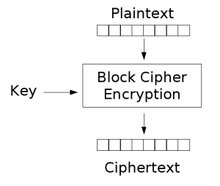Functional encryption
Functional encryption (FE) is a generalization of public-key encryption in which possessing a secret key allows one to learn a function of what the ciphertext is encrypting.
 | |
| General | |
|---|---|
| Designers | Amit Sahai Brent Waters, Dan Boneh, Shafi Goldwasser, Yael Kalai |
| Derived from | Public-key encryption |
| Related to | Homomorphic encryption |
Formal definition
More precisely, a functional encryption scheme for a given functionality consists of the following four algorithms:
- : creates a public key and a master secret key .
- : uses the master secret key to generate a new secret key for the function .
- : uses the public key to encrypt a message .
- : uses secret key to calculate where is the value that encrypts.
The security of FE requires that any information an adversary learns from an encryption of is revealed by . Formally, this is defined by simulation.[1]
Applications
Functional encryption generalizes several existing primitives including Identity-based encryption (IBE) and attribute-based encryption (ABE). In the IBE case, define to be equal to when corresponds to an identity that is allowed to decrypt, and otherwise. Similarly, in the ABE case, define when encodes attributes with permission to decrypt and otherwise.
History
Functional encryption was proposed by Amit Sahai and Brent Waters in 2005[2] and formalized by Dan Boneh, Amit Sahai and Brent Waters in 2010.[3] Until recently, however, most instantiations of Functional Encryption supported only limited function classes such as boolean formulae. In 2012, several researchers developed Functional Encryption schemes that support arbitrary functions.[1][4][5][6]
References
- Goldwasser, Shafi; Kalai, Yael; Ada Popa, Raluca; Vaikuntanathan, Vinod; Zeldovich, Nickolai (2013). Reusable garbled circuits and succinct functional encryption - Stoc 13 Proceedings of the 2013 ACM Symposium on Theory of Computing. New York, NY, USA: ACM. pp. 555–564. ISBN 978-1-4503-2029-0.
- EUROCRYPT (2005-05-09). Fuzzy Identity-Based Encryption - Advances in Cryptology - EUROCRYPT 2005: 24th Annual International Conference on the Theory and Applications of Cryptographic Techniques, Proceedings. Springer Science & Business Media. ISBN 978-3-540-25910-7.
- Boneh, Dan; Amit Sahai; Brent Waters (2011). "Functional Encryption: Definitions and Challenges" (PDF). Proceedings of Theory of Cryptography Conference (TCC) 2011.
- Gorbunov, Sergey; Hoeteck Wee; Vinod Vaikuntanathan (2013). "Attribute-Based Encryption for Circuits". Proceedings of STOC.
- Sahai, Amit; Brent Waters. "Attribute-Based Encryption for Circuits from Multilinear Maps" (PDF). Cite journal requires
|journal=(help) - Goldwasser, Shafi; Yael Kalai; Raluca Ada Popa; Vinod Vaikuntanathan; Nickolai Zeldovich (2013). "How to Run Turing Machines on Encrypted Data" (PDF). CRYPTO 2013.